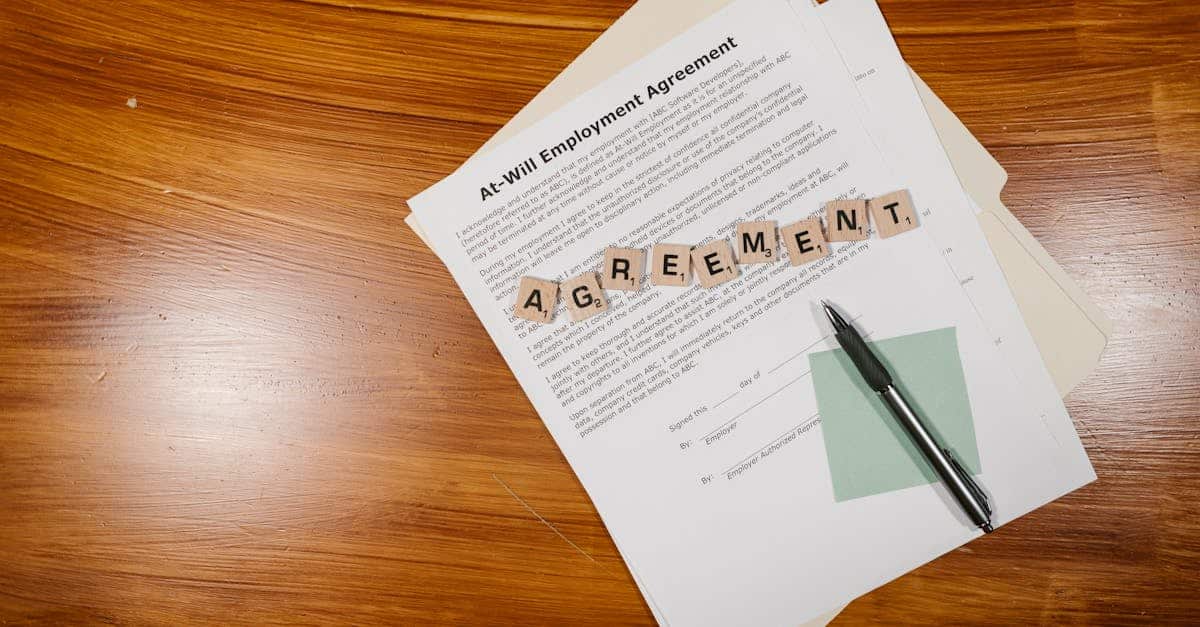
Introduction
Small omissions or vague wording in employment paperwork are rarely harmless — they create compliance gaps, payroll surprises, and litigation risk just when your company can least afford them. Whether you’re issuing offers, converting contractors, or maintaining an agreement library, a repeatable way to catch missing terms and risky clauses in employee agreements is essential.
How Document AI helps — this article shows you how to build an automated checklist that extracts and normalizes clauses, flags deviations against your templates, scores risk, and feeds results into approval workflows. You’ll get practical checkpoints for compensation, termination, IP and restraints, benefits and notices; a machine‑readable checklist and scoring model; integration patterns that trigger redlines or tasks; real‑world case studies; and a step‑by‑step implementation path to reduce review time and surface high‑value escalations for HR and legal.
Essential review checkpoints: compensation, termination notice, IP assignment, garden‑leave/non‑compete, benefits and statutory notices
Why checkpoints matter
When you review employee agreements — whether a permanent employment contract, a fixed‑term employment agreement, or an independent contractor agreement — missing or ambiguous clauses create legal and operational risk. Use this checklist as the minimum gate before sign‑off or filing.
Core checklist items
-
Compensation: clear base pay, bonus structure, equity terms, payroll frequency, and any variable pay calculation methods. Link offer language back to your job offer letter templates.
-
Termination notice & severance: notice periods, cause vs. without cause, garden‑leave mechanics, and any severance agreement triggers or formula. Flag inconsistencies with company policy or local law (e.g., employee agreements UK differences).
-
IP assignment & inventions: assignment and disclosure obligations, scope of work product, and post‑termination cooperation for transfer of rights.
-
Garden‑leave / non‑compete / restraints: enforceability, duration, geographic scope, and compensation during garden‑leave. Ensure these clauses comply with jurisdictional rules.
-
Benefits and statutory notices: pension/retirement, health benefits, statutory leave entitlements, and any handover notices required by local employment law.
-
Confidentiality: presence of a non‑disclosure agreement (nda) clause or separate NDA. If you use a standalone NDA template, cross‑reference it — see a sample non‑disclosure agreement for standard language.
Practical checks
-
Confirm the contract type matches the working relationship — misclassifying an employee as an independent contractor can create tax and benefits liabilities.
-
Compare against your employee agreements template and employee agreements sample to catch missing fields like probation length, hours, or benefits enrollment deadlines.
-
Note jurisdictional placeholders (e.g., California vs. UK) and ensure statutory notices are present for that location. For California‑specific employment agreement language, see an example here.
How Document AI extracts clauses, normalizes language and highlights deviations from your standard templates
Clause extraction explained
Document AI uses NLP to locate clause headings and sentence patterns (for example: “termination”, “notice period”, “confidentiality”, “invention assignment”). It pulls the clause text, metadata (location in the document, length), and key variables (days of notice, pay formula, date ranges).
Normalization and canonicalization
After extraction, AI maps clause variants to a canonical clause model so your legal team sees one normalized view. For example, “30 days’ pay in lieu” and “one month’s salary on termination” both normalize to a single termination‑pay field with a numeric value.
Deviation detection
AI compares the normalized clause to your reference template library and highlights deviations: missing clauses, broader scopes, or non‑standard language. Deviations are surfaced with severity tags (e.g., informational, moderate, high) to help prioritize legal review.
Output formats: structured JSON with clause types, normalized fields, deviation flags, and excerpted text for quick review by HR or counsel.
Designing a machine‑readable checklist and risk scoring for HR and legal teams
Define the checklist schema
Build a JSON‑friendly checklist that each clause maps to. Fields should include: clause_id, clause_type, normalized_value, expected_value, deviation_flag, risk_level, and remediation_recommendation.
Sample risk factors
-
Severity: legal exposure if clause is incorrect (e.g., unenforceable non‑compete).
-
Frequency: how often the deviation appears across documents (helps spot systemic policy drift).
-
Impact: payroll, IP ownership, regulatory fines, or litigation risk.
Scoring model
Create a weighted scoring model where certain clause types (IP assignment, termination, confidentiality) carry higher weights. The final risk score feeds a color code (green, amber, red) and actionable next steps for HR or legal.
Operationalizing the checklist
-
Expose the machine‑readable checklist to HR dashboards so PIP owners can see outstanding issues.
-
Keep the checklist versioned with your template library so audits can show which template version was the standard at the time of signing.
Integrations: feed AI findings into approval workflows, tasking PIP owners, or triggering redlines for legal review
Integration patterns
Feed Document AI outputs into your existing systems via APIs or connectors: ATS, HRIS, CLM (contract lifecycle management), or ticketing systems. Common flows include auto‑populating fields in your HRIS, creating a legal review ticket, or sending an approval request to hiring managers.
Automated actions
-
Trigger redlines: when a high‑severity deviation is found, generate a suggested redline and attach it to the contract for legal review.
-
Task assignment: create tasks for PIP (performance improvement plan) or onboarding owners to fix benefits, sign NDAs, or confirm payroll setup.
-
Approval gating: block final signature in your CLM until critical checkpoints (compensation, IP assignment, confidentiality) are green.
Implementation tips
-
Use webhooks to push findings into Slack, Teams, or email for real‑time alerts.
-
Map AI severity levels to workflow priorities so legal only sees high‑value escalations.
-
Keep an audit trail of automated edits and redlines for compliance and dispute defense.
Case studies: speeding review of bulk contractor conversions and outbound offer audits
Bulk contractor conversions
Problem: A fast‑growing company needed to convert 200 independent contractors into employees to comply with evolving classification rules. Manual review was taking weeks and creating inconsistency in key clauses like IP assignment and benefits.
-
AI solution: batch extraction from all contractor agreements, normalization against an employee agreements template, and a risk score for each file.
-
Outcome: High‑risk files were routed to legal (15%), medium risk to HR for remediation (35%), and the remaining 50% cleared for standard conversion. Review time dropped from 6 weeks to 72 hours.
Outbound offer audits
Problem: Recruiting was issuing customized offer letters with inconsistent termination and equity terms, creating downstream payroll and compliance issues.
-
AI solution: scan outbound offer letters against approved job offer letter templates and your clause library, flagging deviations in compensation, probation, and garden‑leave clauses.
-
Outcome: Automated pre‑send checks prevented 30% of non‑standard offers from going out, reduced manual redlines, and improved time‑to‑hire. Use a standard job offer letter template as the authoritative source.
Implementation steps: training models on your clause library, setting thresholds, and monitoring false positives
Step 1 — Prepare your clause library
Gather canonical clauses from your employee agreements (including employment contract, severance agreement, and non‑disclosure agreement samples). Version and tag by jurisdiction and document type (permanent, fixed‑term, independent contractor agreement).
Step 2 — Label and train
Manually label a representative sample of agreements to teach the model to recognize headings, clause boundaries, and key variables. Fine‑tune using those annotations until extraction precision and recall meet your targets.
Step 3 — Set thresholds and severity rules
Define confidence thresholds for automatic approvals vs. human review. For example, set a higher threshold for IP assignment and non‑compete clauses than for non‑material formatting differences.
Step 4 — Pilot and monitor
Run a pilot on a subset of agreements and track false positives/negatives. Keep a feedback loop where legal and HR correct AI outputs and those corrections retrain the model.
Step 5 — Governance and ongoing tuning
Schedule regular audits of the model, adjust weights in the risk scoring, and maintain logs for compliance. Track metrics like time saved, review accuracy, and number of escalations to quantify ROI.
For templates you can adopt or compare against, reference your NDA and employment agreement samples as part of the clause library — for example the standalone non‑disclosure agreement and a sample employment agreement for jurisdictional language.
Summary
Automating clause extraction and a machine‑readable checklist lets HR and legal teams catch missing terms, flag risky language, and standardize reviews so you reduce manual work and surface only the highest‑value escalations. By combining normalized clause models, a weighted risk score, and workflow integrations you speed reviews, improve consistency, and create an auditable trail for compliance—critical when managing employee agreements at scale. Ready to get started? Explore templates and integrations at https://formtify.app.
FAQs
What is an employee agreement?
An employee agreement is a written or verbal arrangement that sets out the terms of employment, including duties, pay, benefits, and notice periods. It helps both parties understand obligations and can include clauses for confidentiality, IP assignment, and restraints.
Do employee agreements have to be written?
In many jurisdictions, certain terms are legally enforceable even if not in writing, but a written agreement reduces ambiguity and provides evidence in disputes. For practical and compliance reasons, it’s best practice to document core terms in writing and keep a signed copy on file.
Can an employer change an employee agreement?
An employer can change terms, but changes typically require consent or a valid contractual mechanism (such as a variation clause) and must comply with local employment law. Unilateral changes to essential terms like pay or hours can create legal risk or breach of contract claims.
What should be included in an employment agreement?
Key elements include compensation details, job duties, hours, benefits, termination notice and severance terms, IP assignment, confidentiality, and any restraints. Including jurisdictional statutory notices and probation or benefits enrollment deadlines is also important for compliance.
How long should I keep employee agreements?
Retention periods vary by jurisdiction and document type, but keep signed agreements for the length of employment plus any statutory limitation period for claims (often several years). Maintain versioning and an audit trail so you can demonstrate which template and terms applied at the time of signing.





